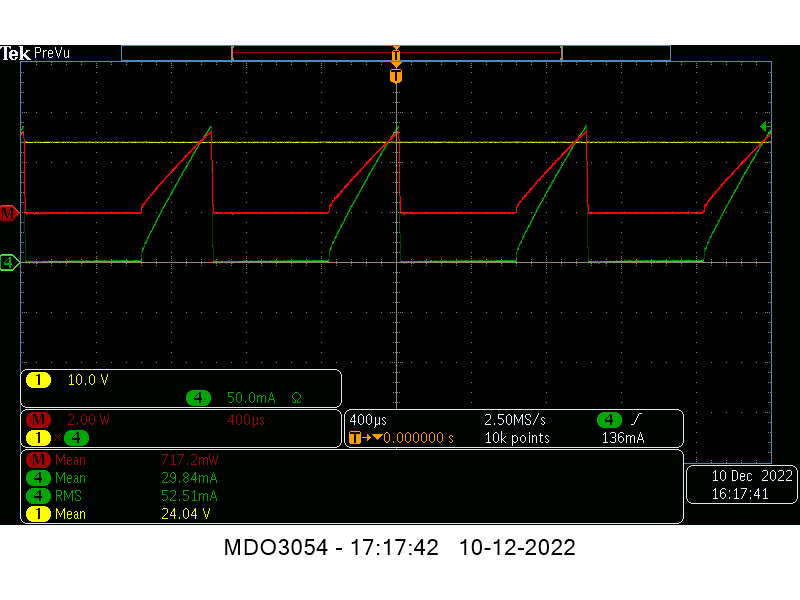All,
I made a quick replication of Jagau his setup using a similar single 120V / 4W bulb as load like Jagau and setting the FG to 1kHz @ 38% duty cycle.
The bulb is not brightly on, but pulls 536mW.
The result can be seen in the screenshot:

So, i have:
24V DC input directly across the 24V PS, yellow trace,
52.5mA rms triangle shaped pulsed DC input directly taken from the minus lead of the 24V PS, green trace (also note the lower 29.8mA average current).
Power input calculated via yellow x green, red trace.
When using Jagau his formula Pin = I x V x SQRT(Duty Cycle) / SQRT(3T) i get:
Pin = 0.0525 x 24 x SQRT(380) / SQRT(3000) (380us Duty cycle, 1000us Frequency)
Pin = 0.448mW.
So, with the 536mW output in the bulb i have a COP = 1.2 here!!
But looking again at the screenshot, we also see the instantaneously calculated power using the math function Voltage (yellow) x current (green) being 717mW (the scope does NOT use rms nor mean nor p2p values here).
We also see the average current being 29.8mA and the average voltage being 24V, so as both being (pulsed) DC we can multiply these to get the Power being also 715mW.
Calculating the COP now shows we drop to COP = 0.75.
So where does that difference between calculated power (448mW) and via the scope measured / calculated power (717mW / 715mW) comes from?
My interpretation is that the used formula uses the "frequency / Duty cycle relation" twice.
Once in the formula itself (right part), and once already imbedded into the used Irms value, let me explain.
The formula presented here, https://masteringelectronicsdesign.com/how-to-derive-the-rms-value-of-a-triangle-waveform/ (specially tailored for triangle shaped (the current) signals) shows as formula (4) this:
Irms_triangle = Ip SQRT t1/3T.
It means that we calculate Irms from Ipeak using this frequency / duty cycle relationship, so let’s do that to see if we get the same Irms:
Ip = 138.6mA, so Irms = 0.1386 x SQRT 380/3000 = 49mA rms, which is very close to the 52mA rms on the scope.
So, if Irms already has this freq. / duty cycle relation inside it, we should not again do that in the above formula from Jagau, so there for i think this formula is wrong.
This formula is also not needed IMO as we, as shown above, are dealing with DC and triangle pulsed DC signals only for which we can simply multiply the average Voltage and average Current values.
Here i ask Jagau to put up on his scope the average voltage on CH1 (24V) and the average current on CH2 again and use the math function CH1 x CH2 to show the calculated power on input or simply multiply the average current value with the average voltage value to get the input power.
I invite every member of this forum skilled or not to explain the difference seen between the calculated by formula input power and the measured / calculated by the scope input power and which of the 2 methods is the correct one.
Thanks, Regards Itsu







